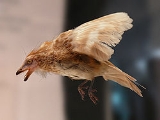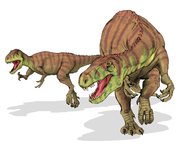
Hauterivian
Encyclopedia
The Hauterivian is, in the geologic timescale, an age in the Early Cretaceous
epoch
or a stage in the Lower Cretaceous series
. It spans the time between 136.4 ± 2 Ma and 130 ± 1.5 Ma (million years ago). The Hauterivian is preceded by the Valanginian
and succeeded by the Barremian
.
geologist Eugène Renevier
in 1873. It is named after the Swiss town of Hauterive
at the shore of Lake Neuchâtel
.
The base of the Hauterivian is defined as the place in the stratigraphic column
where the ammonite
genus
Acanthodiscus
first appears. A reference profile for the base (a GSSP) had in 2009 not yet been established. The top of the Hauterivian (the base of the Barremian) is at the first appearance of ammonite species Spitidiscus hugii.
In the ammonite biostratigraphy
of the Tethys domain
, the Hauterivian contains seven ammonite biozone
s:
Early Cretaceous
The Early Cretaceous or the Lower Cretaceous , is the earlier or lower of the two major divisions of the Cretaceous...
epoch
Epoch (geology)
An epoch is a subdivision of the geologic timescale based on rock layering. In order, the higher subdivisions are periods, eras and eons. We are currently living in the Holocene epoch...
or a stage in the Lower Cretaceous series
Series (stratigraphy)
Series are subdivisions of rock layers made based on the age of the rock and corresponding to the dating system unit called an epoch, both being formally defined international conventions of the geological timescale. A series is therefore a sequence of rock depositions defining a...
. It spans the time between 136.4 ± 2 Ma and 130 ± 1.5 Ma (million years ago). The Hauterivian is preceded by the Valanginian
Valanginian
In the geologic timescale, the Valanginian is an age or stage of the Early or Lower Cretaceous. It spans between 140.2 ± 3.0 Ma and 136.4 ± 2.0 Ma...
and succeeded by the Barremian
Barremian
The Barremian is an age in the geologic timescale between 130.0 ± 1.5 Ma and 125.0 ± 1.0 Ma). It is a subdivision of the Early Cretaceous epoch...
.
Stratigraphic definitions
The Hauterivian was introduced in scientific literature by SwissSwitzerland
Switzerland name of one of the Swiss cantons. ; ; ; or ), in its full name the Swiss Confederation , is a federal republic consisting of 26 cantons, with Bern as the seat of the federal authorities. The country is situated in Western Europe,Or Central Europe depending on the definition....
geologist Eugène Renevier
Eugène Renevier
Eugène Renevier Swiss geologist, was born at Lausanne, Switzerland, as a descendant of a noble family.In 1857 he became professor of geology and paleontology in the University of Lausanne...
in 1873. It is named after the Swiss town of Hauterive
Hauterive, Neuchâtel
Hauterive is a municipality in the district of Neuchâtel in the Français canton of Neuchâtel.-History:Hauterive is first mentioned about 1148 as arta ripa. The village's beginnings were first recorded in 1443 when monks founded the monastery Fontaine-André.-Geography:Hauterive has an area, , of...
at the shore of Lake Neuchâtel
Lake Neuchâtel
Lake Neuchâtel is a lake in Romandy, Switzerland . The lake lies mainly in the canton of Neuchâtel, but is also shared by the cantons of Vaud, of Fribourg, and of Bern....
.
The base of the Hauterivian is defined as the place in the stratigraphic column
Stratigraphic column
A stratigraphic column is a representation used in geology and its subfield of stratigraphy to describe the vertical location of rock units in a particular area....
where the ammonite
Ammonite
Ammonite, as a zoological or paleontological term, refers to any member of the Ammonoidea an extinct subclass within the Molluscan class Cephalopoda which are more closely related to living coleoids Ammonite, as a zoological or paleontological term, refers to any member of the Ammonoidea an extinct...
genus
Genus
In biology, a genus is a low-level taxonomic rank used in the biological classification of living and fossil organisms, which is an example of definition by genus and differentia...
Acanthodiscus
Acanthodiscus
Acanthodiscus is an extinct ammonoid cephalopod genus from the order Ammonitida and included in the persphinctacean family Berriasellidae. The type, named by Bruguière ,1779, is Acanthodiscus radiatus.-Description:...
first appears. A reference profile for the base (a GSSP) had in 2009 not yet been established. The top of the Hauterivian (the base of the Barremian) is at the first appearance of ammonite species Spitidiscus hugii.
In the ammonite biostratigraphy
Biostratigraphy
Biostratigraphy is the branch of stratigraphy which focuses on correlating and assigning relative ages of rock strata by using the fossil assemblages contained within them. Usually the aim is correlation, demonstrating that a particular horizon in one geological section represents the same period...
of the Tethys domain
Tethys Ocean
The Tethys Ocean was an ocean that existed between the continents of Gondwana and Laurasia during the Mesozoic era before the opening of the Indian Ocean.-Modern theory:...
, the Hauterivian contains seven ammonite biozone
Biozone
Biostratigraphic units or Biozones are intervals of geological strata that are defined on the basis of their characteristic fossil taxa....
s:
- zone of Pseudothurmannia ohmi
- zone of Balearites balearisBalearitesBalearites is an extinct genus of cephalopod belonging to the Ammonite subclass....
- zone of Plesiospitidiscus ligatus
- zone of Subsaynella sayni
- zone of Lyticoceras nodosoplicatus
- zone of Crioceratites loryiCrioceratitesCrioceratites is an ammonite genus from the Early Cretaceous belonging to the Ancylocerataceae.Crioceritites is coiled in an open, normally equiangular spiral with an oval or subquadrate whorl section...
- zone of Acanthodiscus radiatusAcanthodiscusAcanthodiscus is an extinct ammonoid cephalopod genus from the order Ammonitida and included in the persphinctacean family Berriasellidae. The type, named by Bruguière ,1779, is Acanthodiscus radiatus.-Description:...
Aves (birds)
| Birds of the Hauterivian | ||||
|---|---|---|---|---|
| Taxa | Presence | Location | Description | Images |
| Disputed Berriasian Berriasian In the geological timescale, the Berriasian is an age or stage of the Early or Lower Creteceous. It is the oldest or lowest subdivision in the entire Cretaceous. It spanned between 145.5 ± 4.0 Ma and 140.2 ± 3.0 Ma... -Hauterivian |
Auxerre Auxerre Auxerre is a commune in the Bourgogne region in north-central France, between Paris and Dijon. It is the capital of the Yonne department.Auxerre's population today is about 45,000... , Yonne, France |
 |
||
|
Iberomesornis Iberomesornis is a monotypic genus of enantiornithine bird of the Cretaceous of Spain.In 1985 the fossil of Iberomesornis was discovered by Armando Díaz Romeral in the Early Cretaceous Calizas de La Huérguina Formation at Las Hoyas, Cuenca Province, east central Spain, which dates to the late... |
Hauterivian to Barremian Barremian The Barremian is an age in the geologic timescale between 130.0 ± 1.5 Ma and 125.0 ± 1.0 Ma). It is a subdivision of the Early Cretaceous epoch... |
La Huérgina Formation, Castilla-la-Mancha, Spain | ||
†Ornithischians
| Ornithischians of the Hauterivian | ||||
|---|---|---|---|---|
| Taxa | Presence | Location | Description | Images |
|
 |
|||
|
Isle of Wight, England | A dryosaurid | ||
Mammalia (mammals)
| Mammals of the Hauterivian | ||||
|---|---|---|---|---|
| Taxa | Presence | Location | Description | Images |
|
several species from Hauterivian to Albian Albian The Albian is both an age of the geologic timescale and a stage in the stratigraphic column. It is the youngest or uppermost subdivision of the Early/Lower Cretaceous epoch/series. Its approximate time range is 112.0 ± 1.0 Ma to 99.6 ± 0.9 Ma... |
Spain, Mongolia | ||
†Plesiosaurs
| Plesiosaurs of the Hauterivian | ||||
|---|---|---|---|---|
| Taxa | Presence | Location | Description | Images |
|
 |
|||
†Pterosauria
| Pterosaurs of the Hauterivian | ||||
|---|---|---|---|---|
| Taxa | Presence | Location | Description | Images |
|
Disputed, considered Tithonian Tithonian In the geologic timescale the Tithonian is the latest age of the Late Jurassic epoch or the uppermost stage of the Upper Jurassic series. It spans the time between 150.8 ± 4 Ma and 145.5 ± 4 Ma... by some |
|||
†Sauropods
| Sauropods Sauropoda Sauropoda , or the sauropods , are an infraorder of saurischian dinosaurs. They had long necks, long tails, small heads , and thick, pillar-like legs. They are notable for the enormous sizes attained by some species, and the group includes the largest animals to have ever lived on land... of the Hauterivian |
||||
|---|---|---|---|---|
| Taxa | Presence | Location | Description | Images |
|
||||
|
Aragosaurus Aragosaurus was a genus of sauropod dinosaur from the Early Cretaceous period of Galve, province of Teruel, in the autonomous territory of Aragón, Spain.... |
||||
†Theropods (non-avian)
| Non-Avian Theropods Theropoda Theropoda is both a suborder of bipedal saurischian dinosaurs, and a clade consisting of that suborder and its descendants . Dinosaurs belonging to the suborder theropoda were primarily carnivorous, although a number of theropod groups evolved herbivory, omnivory, and insectivory... of the Hauterivian |
||||
|---|---|---|---|---|
| Taxa | Presence | Location | Description | Images |
|
  |
|||
|
Valanginian Valanginian In the geologic timescale, the Valanginian is an age or stage of the Early or Lower Cretaceous. It spans between 140.2 ± 3.0 Ma and 136.4 ± 2.0 Ma... to Hauterivian |
Thailand | ||
|
Harpymimus Harpymimus is a basal ornithomimosaurian theropod dinosaur from the Early Cretaceous Period of what is now Mongolia. Unlike later, more derived ornithomimosaurs, Harpymimus still possessed teeth, although they appear to have been restricted to the dentary of the lower jaw.-Discovery and naming:In... |
Hauterivian to Barremian Barremian The Barremian is an age in the geologic timescale between 130.0 ± 1.5 Ma and 125.0 ± 1.0 Ma). It is a subdivision of the Early Cretaceous epoch... |
Shinekhudug Formation, Eastern Gobi province, Mongolia | ||
|
Ligabueino Ligabueino is a genus of noasaurid dinosaur named after Italian doctor Giancario Ligabue. It is known only from an extremely fragmentary specimen, measuring 70 cm long. In spite of initial reports that it was an adult, the unfused vertebrae indicate that the specimen was a juvenile... |
||||
†Ammonites
| Ammonites of the Hauterivian | ||||
|---|---|---|---|---|
| Taxa | Presence | Location | Description | Images |
|
||||
|
Acanthodiscus Acanthodiscus is an extinct ammonoid cephalopod genus from the order Ammonitida and included in the persphinctacean family Berriasellidae. The type, named by Bruguière ,1779, is Acanthodiscus radiatus.-Description:... |
Argentina | |||
|
Abrytasites Abrytasites is an extinct genus of cephalopod belonging to the Ammonite subclass. There are two described species of Abrytasites, A. thieuloyi and A. neumayri. This animal lived 130-136.4 million years ago during the Hauterivian in what is now Czech Republic.-External links:**... |
Czech Republic | |||
External links
- GeoWhen Database - Hauterivian
- Mid-Cretaceous timescale, at the website of the subcommission for stratigraphic information of the ICS
- Stratigraphic chart of the Lower Cretaceous, at the website of Norges Network of offshore records of geology and stratigraphy
- Hauterivian Microfossils: 25+ images of Foraminifera

